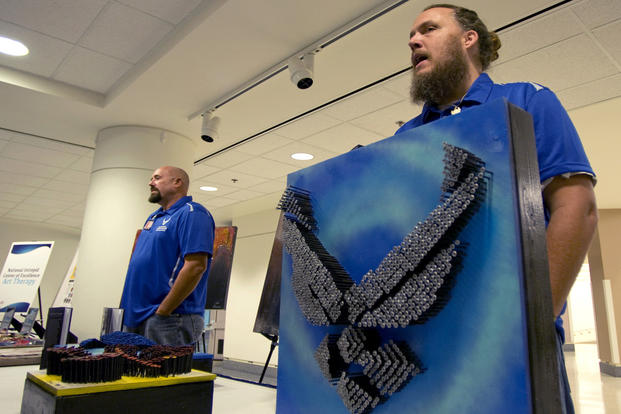As a mortuary affairs Airman, retired Master Sgt. Justin Jordan handled dozens of bodies of service members, many of whom were killed downrange.
But one mission at Davis-Monthan Air Force Base, Arizona, finally made him crack. Jordan was called to a maintenance facility for a deceased male who had been fatally run over by a forklift. That male turned out to be a good friend.
“That was the tipping point for me,” he said. “Everything I had seen before started pouring into my mind.”
Jordan said he slipped into a deep depression, became irritable and disassociated, and drank heavily to drown the emotions. But, he said, he grew tired of taking bottles of medication to cope with his post-traumatic stress disorder. So, he focused on art.
Eight wounded warriors, four of whom are current or former Airmen, including Jordan, were recognized during a Defense Department Warrior Care healing arts event Nov. 12 at the Pentagon.
The group is among more than 1,100 wounded military members who've taken part in a healing arts program since late 2011, when the DOD partnered with the National Endowment for the Arts to offer art therapy to recovering troops.
“By creating art and then taking it to its full extent, they have an opportunity to externalize things that may have been repressed for a long time,” Dr. Jonathan Woodson, the assistant secretary of defense for health affairs, said at the event. “It can often sort out what has been overwhelming to them and identify the underlying causes of their emotions.”
Jordan, who served 20 years in the Air Force, paints and writes to channel his haunting experiences into a positive outlet. His work includes a book, “And Then I Cried: Stories of a Mortuary NCO.”
“You can lose yourself in art,” he said. “The memories don,t have control of me anymore.”
Not only invisible scars
A ride to Camp Doha, Kuwait, back in 2004 changed the life of Tech. Sgt. Mallory Dinkel, who left the Air Force earlier this year after serving almost 12 years.
The former security forces Airman was in a Humvee when an oncoming semitrailer went into her lane. Her Humvee veered to the side of the road, causing it to roll over multiple times. But her right leg was partially ejected after her door flew open and was crushed when the Humvee rested on top on it, she said.
More than a decade later, the 29 year old still walks with a limp and uses a cane. As a natural painkiller, she paints.
“It gives me an escape,” she said. “And in that moment of time, I,m not thinking about my chronic pain. I,m thinking about my painting.”
Family strong
The suffering also extends to family members who care for wounded veterans.
When Heather Miller,s husband redeployed from Iraq in 2008, she hardly recognized him.
“He was a laid back, artistic, goes with the flow type of person,” she said. “But when he returned, he was the complete opposite -- angry, short-tempered, depressed.”
She has struggled to find the right therapy for her husband, who she said has attempted to commit suicide multiple times by overdosing on pills.
Former Staff Sgt. Gregory Miller, her husband, then joined the healing arts program last year as a way to cope with his PTSD and anxiety.
“It brings me peace,” he said of his work with mixed media and acrylic paints. “I'm in another world when I do my artwork. There are no worries and I'm just creating something.”
Heather says her husband, whose condition can result in him being distant to others, now has interest in mentoring others in similar situations.
“I would encourage veterans to try new activities to see what avenues work best for them,” he said, “whether that be sports, music or art.”
Jordan, who now serves as the director of suicide awareness for Tactical 16, a veteran-run publishing firm, believes that advocacy for others can bring the real healing.
“When you can help your fellow brother or sister in any way, you have a mission again,” he said. “You’re able to get to post-traumatic growth, not post-traumatic stress.”










